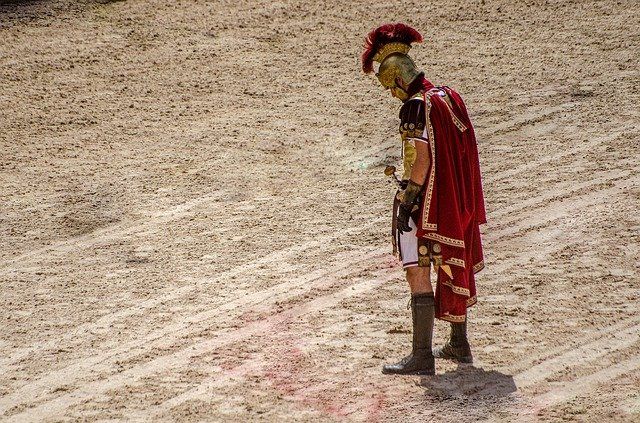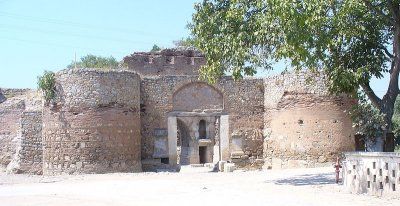It is probably true to say that Christians were a very small minority in Britain until well into the fourth century. Few church buildings dating from the third and fourth centuries have been uncovered in the course of archaeological excavation, and those which have been found tend to be small.
This might be because the earliest British believers were not interested in erecting church buildings. But it is more likely that Christians were relatively few in those very early days.
Heresy
Christian symbols have been identified on objects manufactured in Britain during the fourth century. This is sometimes taken to imply widespread acceptance of the Christian faith. However, it may prove only that there was a generally favourable attitude towards a religion embraced by the Emperor!
It tells us little or nothing about the beliefs of those who bought such objects. Even today, many a non-Christian woman wears a cross around her neck as an item of jewellery.
Most probably, then, the Church in third and fourth-century Britain was a small minority.
The next major event affecting the British churches was the outbreak of the Arian heresy. Arius, who came from Alexandria in Egypt, denied that Jesus Christ was truly divine. Bede records that ‘this poisonous error, after corrupting the whole world, at length crossed the sea and infected even this remote island’.

It has been said that the heresies of the fourth-century, which played a significant role in church affairs on the Continent, seem to have had little influence in Britain. This does not necessarily conflict with Bede’s statement.
Arianism probably made little headway in Britain, but it certainly came to this country.
Defending the truth
Archaeologists found a letter in Bath addressed to a lady named Nigra. It is from a Christian man called Vinisius of Wroxeter, near Shrewsbury. He warns Nigra of the arrival of one Bilonicus, ‘a dog of Arius’ — a derogatory term for a follower of the heretic.
We shall not here trace the history of the Arian controversy. Suffice it to say that the Council of Nicaea, which met in 325, drew up a creed defending the truth about the Lord Jesus Christ.
For most of the rest of the fourth century, in a lengthy series of church councils, the Church underwent a long drawn-out process of defending the Nicene Creed against Arian attack.
The greatest champion of orthodoxy against the Arians was Athanasius. He refers three times in his writings to the way the British churches had accepted the declarations of the truth about the Lord Jesus Christ formulated at Nicaea.

In 363 he wrote a letter to Jovian, a supporter of the true doctrine, who was Emperor for just a few months. Athanasius says that, with a few exceptions, ‘all the Churches in every quarter, both those in Spain, and Britain’ (the list continues with the names of another 20 provinces) ‘have assented to the Nicene Creed.
Athanasius explains that he has this information partly by personal experience and partly from letters.
International councils
Similar geographical lists occur in two other works by Athanasius. In his Defence Against the Arians he refers to the Council of Sardica, which met, probably in 343 or 344. An Arian group had manipulated things in an attempt to get Athanasius dismissed from his pastorate in Alexandria.
This led to a dispute within the church there. The Council of Sardica met to settle this dispute and decided for Athanasius.
In his Introduction he writes: ‘The sentence that was passed in my favour received the approval of more than three hundred bishops, out of the provinces of…’ There follows a list of 36 regions of the Empire.
The last mentioned is Britain. Similarly, in his History of Arianism he speaks of the peace that by then existed between himself and the bishops from all over the world, including Britain.
It is sometimes suggested that Britain may have been represented at Nicaea. There is no evidence for this. However, we do know that British church leaders were present in some numbers at one of the international councils which sat during those years of controversy, that at Rimini in Italy in AD 359. This council saw a temporary victory for the Arians.
However, within two years, following another council at Alexandria, skilfully managed by Athanasius, Arianism practically disappeared from the western churches.
Church life
It is an interesting question as to what form church life took in Britain in those early days. The first Christian churches everywhere were run as local communities, with elders chosen from the congregation.
There were no official hierarchies. Small congregations worshipped together, cared for their members, and spread the gospel in their own areas.
By the third century, however, Christianity was moving away from its original looseness of organisation. It became more strongly structured. The role of a bishop as leader of a regional presbytery (a diocese) became crucial.
Eventually bishops were nominated by the clergy without reference to the rest of the church, and a hierarchical scheme developed. Nevertheless, it seems that these developments had less impact in Britain. Being an island, the country was isolated to some extent from events occurring in the continental empire.
An Orthodox clergyman called Brother Aidan has written that ‘the Church in Roman Britain used the customary diocesan system’. He deduces this from the records of the Council of Arles which, he claims, refer to bishops in Britain.
However, he could be mistaken. Episcopal organisation has been so dominant down the ages that the system is sometimes ‘read back’ wrongly into earlier times. I have been using the word ‘pastor’ rather than ‘bishop’ in these articles so far, because the Greek word can be translated either way.
Small flocks
Interestingly, the same Orthodox clergyman points out that three of the British ‘bishops’ who attended the Council of Rimini accepted payment of their expenses from the imperial treasury.
Neither they nor their churches could afford to meet the cost of the trip. Aidan writes: ‘It is likely that the three poor bishops came from smaller towns, which supports the picture that as well as bishops in big towns, there were also “provincial” bishops to cater for smaller, perhaps more remote areas’.
But there is an alternative explanation. The fact that some bishops could not afford the trip without help may suggest that the popular view of a bishop’s role in those days is incorrect.
Perhaps they were local pastors. Evidence for this is found in something else that Aidan says: ‘It needs to be kept in mind that in these early times a bishop’s flock could be very small, even as low as one hundred’.
This does not tally with the idea that a bishop was a diocesan leader. The early British church was far more localised in its organisation. Whether it resembled Independency or Presbyterianism is impossible to say.
Pelagius
In the early years of the fifth century a heresy originated with a British connection. It was known as Pelagianism and its repercussions continue to the present day.
Pelagius was born around 350. Most of the evidence suggests he was born in Britain. One ancient writer called him ‘our Briton’, and another described him as ‘by race British’. Augustine refers to him as Brito.
Some historians, however, think that he came from Ireland. This is based on a comment about Pelagius made by Jerome: ‘his offspring is among the Scots, in the neighbourhood of Britain’.
In the fourth century the Scots inhabited Ireland and what we know as Scotland was home to the Picts. Thus Pelagius may have come from Ireland to Britain. On the other hand, the word ‘Scot’ was sometimes used in those days as a term of abuse.
We know nothing about Pelagius’ early life. The first definite information places him in Rome in about 380 or 400. Here he wrote a series of works questioning a number of doctrines.
Celestius
It is hard to be sure precisely what Pelagius believed, since most of his works are lost. Some of the errors associated with his name may be developments of his teaching by his followers, rather than his own views.
His first follower was Celestius. He is the real father of Pelagianism as we know it today. Some think that Celestius came from Ireland but there is no evidence that Pelagius knew him before going to Rome, so Celestius may have been Italian.
In 410 Rome was invaded, defeated and ransacked. Pelagius and Celestius fled to North Africa. Pelagius continued to Palestine, but Celestius stayed in Africa, where he applied to Aurelius, pastor of the church in Carthage, for ordination.
This application brought to light his heterodox beliefs. We shall consider what they were next month










